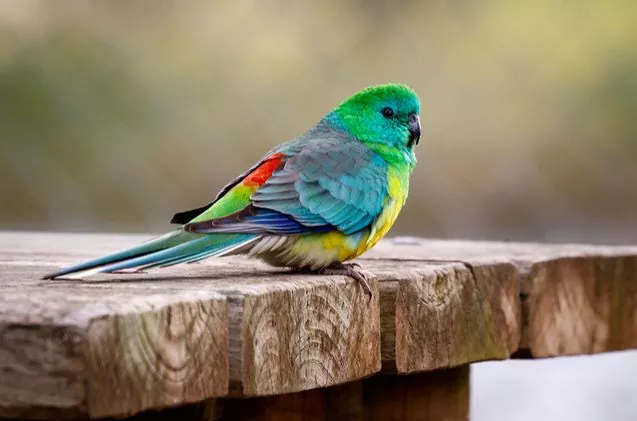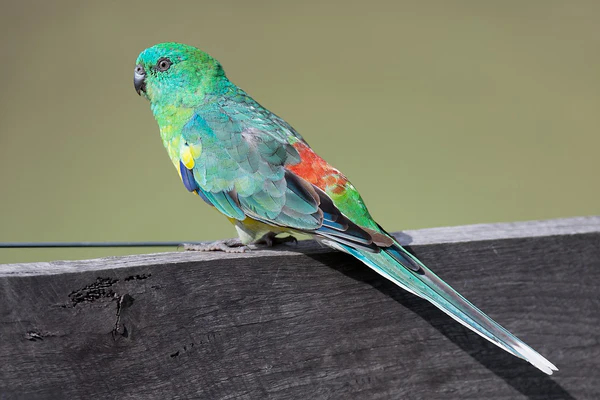
The Red-Rump Parakeet (Psephotus haematonotus) is a striking and vibrant bird known for its colorful plumage and lively personality. Native to southeastern Australia, these birds have become popular pets due to their beautiful appearance and friendly disposition. If you’re considering bringing a Red-Rump Parakeet into your home, or if you’re simply interested in learning more about this fascinating species, this guide provides everything you need to know about their care, behavior, and needs.
Physical Characteristics
The Red-Rump Parakeet is named after the brilliant red patch of feathers located on the lower back of males, which is one of their most distinguishing features. Males are generally more colorful than females, boasting bright green plumage, a blue tail, and a yellowish-green chest. The female, while still attractive, tends to have more subdued colors with olive-green feathers and lacks the vibrant red patch seen in males.
These birds are medium-sized parrots, typically reaching around 10 to 11 inches in length, with a wingspan of about 13 inches. Their slender build and graceful appearance make them one of the more elegant parakeet species.
Natural Habitat and Behavior
In the wild, Red-Rump Parakeets are found in the grasslands and open woodlands of southeastern Australia. They prefer to live in areas with plenty of space to fly, and their natural diet consists mainly of seeds, grasses, and small insects. They are ground foragers, often seen hopping along the ground in search of food.
Red-Rump Parakeets are active and social birds, typically found in pairs or small flocks. In captivity, they maintain their active nature and require a spacious environment that allows for flying and exploration. While they can be somewhat independent compared to other parakeet species, they still enjoy interacting with their owners and can develop strong bonds when given enough attention and care.
Temperament and Socialization
One of the reasons Red-Rump Parakeets have become popular pets is their friendly and relatively easy-going temperament. They are curious and playful birds, though they can be more reserved than other parakeets like budgies or cockatiels. With proper socialization, Red-Rump Parakeets can become affectionate and even enjoy being handled, though they are not as cuddly as some other parrot species.
It’s important to note that these birds can be territorial, especially during the breeding season. If you plan to house them with other birds, it’s crucial to monitor their behavior closely to prevent any aggressive tendencies. Generally, Red-Rump Parakeets are better housed as a single bird or in pairs rather than in large mixed-species aviaries.
Diet and Nutrition
A well-balanced diet is essential for keeping your Red-Rump Parakeet healthy. In captivity, their diet should consist of high-quality parakeet pellets, supplemented with fresh fruits and vegetables. Some of the best fruits and vegetables for Red-Rump Parakeets include:
It’s important to provide a variety of fresh produce to ensure your parakeet is getting all the necessary nutrients. You can also offer seeds and grains, but these should be limited to avoid overfeeding, as they are higher in fat. Red-Rump Parakeets also enjoy foraging, so providing opportunities for them to explore and search for food can help keep them mentally stimulated.

Housing Requirements
Red-Rump Parakeets are highly active and need plenty of space to fly, play, and exercise. A large cage is a must, with ample room for perches, toys, and flight. At a minimum, the cage should be around 30 inches wide, 18 inches deep, and 18 inches high, but bigger is always better, especially for a bird that enjoys flying. These birds can also benefit from time outside the cage in a safe, bird-proofed area for additional exercise and mental stimulation.
Inside the cage, include a variety of perches at different heights, made from different materials such as wood and rope, to keep their feet healthy. Red-Rump Parakeets enjoy toys that challenge their intelligence and keep them entertained. Foraging toys, shredding toys, and bells are all excellent choices. Regular rotation of toys will help prevent boredom and keep your parrot engaged.
Health and Common Issues
Red-Rump Parakeets are generally hardy birds but can be prone to certain health issues if their needs are not properly met. The most common health problems include:
Regular veterinary check-ups with an avian vet are essential to ensure your Red-Rump Parakeet stays in good health.
Breeding
If you’re interested in breeding Red-Rump Parakeets, it’s important to note that they require a spacious aviary and plenty of privacy. Breeding pairs should be housed separately from other birds to avoid territorial conflicts. The breeding season typically occurs in the spring, and pairs may lay anywhere from 4 to 6 eggs. Both parents share the responsibility of incubating the eggs and caring for the chicks once they hatch.
Breeding Red-Rump Parakeets can be a rewarding experience, but it also requires careful planning and commitment to ensure the health and well-being of the birds and their offspring.
Conclusion
Red-Rump Parakeets make wonderful companions for bird enthusiasts who are looking for an active, independent, and beautiful bird. Their striking appearance, playful nature, and relative ease of care make them a popular choice for both novice and experienced bird owners. By providing a spacious environment, a balanced diet, and plenty of mental stimulation, you can ensure your Red-Rump Parakeet thrives in your care.
Do red rump parakeets talk?
Red rump parakeets aren’t known for talking as much as other parrot species. While they may mimic a few sounds or words with effort, they are generally quieter and less vocal. Their primary form of communication is through chirping and whistling, making them suitable for people who prefer a more mellow bird.
Are red-rumped parrots rare?
In captivity, red-rumped parrots aren’t considered rare and are relatively popular as pet birds due to their beautiful coloration and gentle nature. In the wild, they are native to Australia and are commonly found in open woodlands, so they are not considered rare in their natural habitat either.
Can red rump parakeets live with other birds?
Red rump parakeets can sometimes coexist with other bird species, but they are known to be territorial, especially during the breeding season. They are best kept in spacious enclosures or aviaries, ideally with other birds of a similar size and temperament. Close monitoring is essential to ensure harmony, as they can occasionally show aggression toward smaller or less assertive birds.
How long do red rump parrots live?
Red rump parrots have a lifespan of about 15 years in captivity when provided with good care, a nutritious diet, and plenty of mental and physical stimulation. With the right environment, some may even live a bit longer, reaching up to 20 years.
